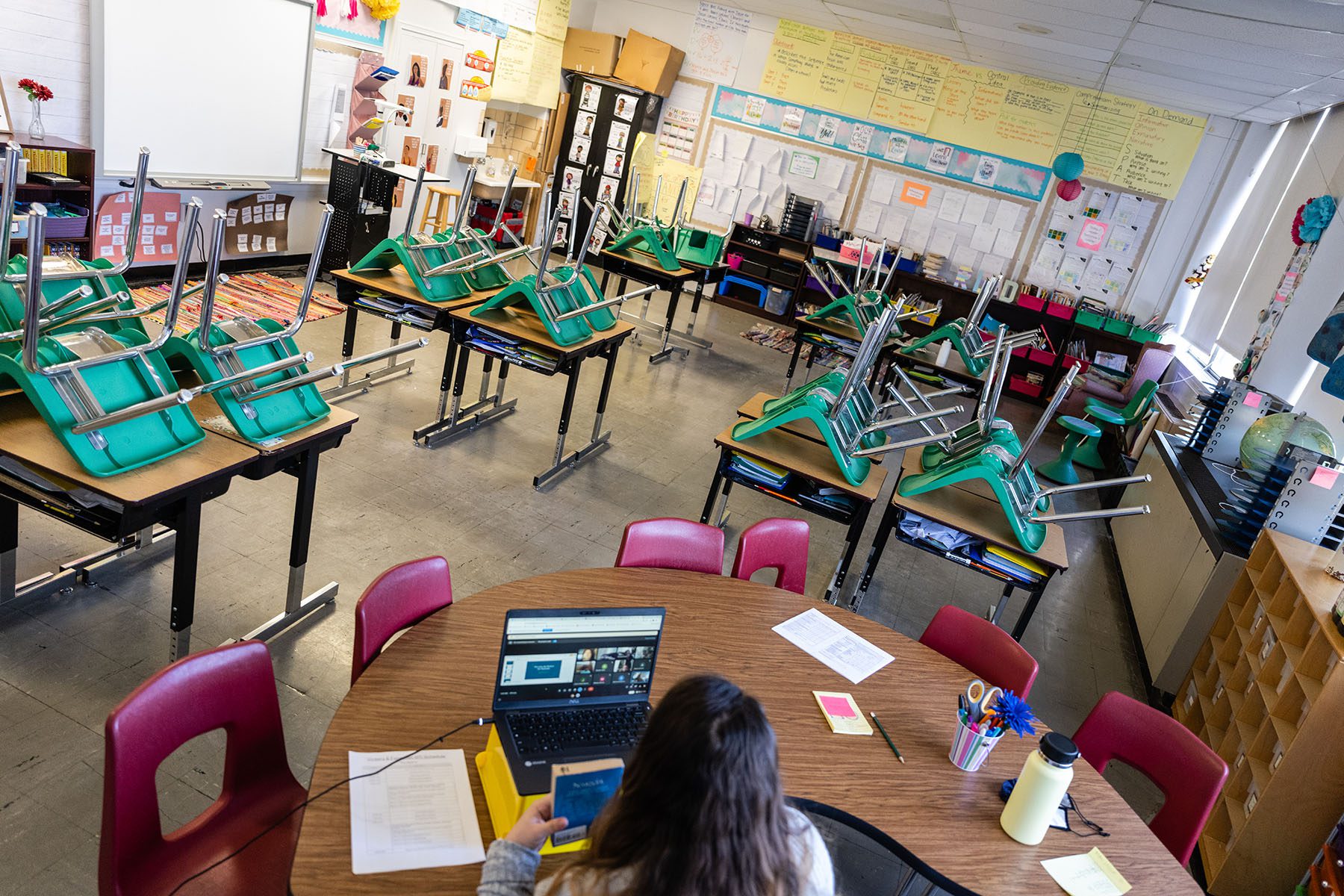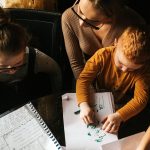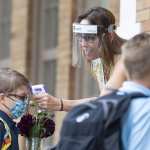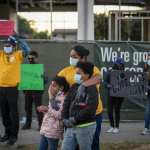When the COVID-19 pandemic started, Winchester Grade School had only enough computers to go home with half of its student body. Now the school in rural Winchester, Illinois, has devices for each of its 400 students. Yet, a major challenge remains if rising coronavirus cases force the school to return to remote instruction: broadband access.
“Thirty-five to 40 percent of our students still don’t have a reliable home internet,” said Principal Andy Stumpf. “While there are a couple of internet options around here, it’s not an option for everyone. So, if we go remote, four out of every 10 students would not even have access to live remote instruction because they don’t have a reliable internet.”
Almost two years after the first unexpected days of remote learning, technological challenges to distance learning persist: Students need access to the internet, digital devices and, often, technical support from their caregivers for remote learning to work. Pandemic relief funds have helped schools significantly expand their computer inventory, and federal, state and local initiatives have made internet more widely available. As COVID cases rise again, staffing shortages and high infection rates have forced schools in states such as Pennsylvania, New Jersey, Maine, California and Ohio to go remote again.
The burdens of dealing with students’ remote learning during the pandemic have largely fallen on mothers, with a 2020 Marketplace-Edison Research Poll finding that 63 percent of women said they were supervising their children’s remote learning compared with just 29 percent of men. The technological barriers to remote learning disproportionately affect families from underprivileged backgrounds due to their race, location, income, immigrant or refugee status. A 2020 University of Southern California (USC) study coauthored by Stephen Aguilar, an assistant professor at USC’s Rossier School of Education, found that 44 percent of low-income Los Angeles parents said they never use computers and 10 percent never use the internet.
Since Aguilar’s study, California passed legislation that has helped more than a million households afford low-cost internet service, but he said that doesn’t mean the families who had little experience using computers and the internet at the start of the pandemic are now as comfortable using them as families with a long history of technology use.
“When we’re thinking about how families are adapting to instruction in the pandemic — people adapt the best they can and they leverage the resources around them,” Aguilar said. “But the resources available to certain communities are obviously different, right?”
School districts that worked toward digital equity before the pandemic found it less challenging to shift students and families to remote instruction than those that didn’t, school administrators told The 19th.
In 2019, the School District of Philadelphia surveyed families about student access to the internet, finding that just 58 percent of high school students, 56 percent of middle school students and 45 percent of elementary school students had Wi-Fi at home.
“We understood that the digital divide is a very real thing, particularly for communities, like many of the ones that we serve, that might be economically disadvantaged,” said Monica Lewis, a School District of Philadelphia spokesperson. “Obviously, we didn’t know that the year after [the survey], there would be a pandemic, but we were aware that digital access is something that we all need for education, for jobs and things of that nature. So, we were very intentional about seeing what our families needed.”
Now 9 out of 10 Philadelphia households with school-age children have an internet connection, according to a new study, a shift that largely occurred after city and school officials directed families to affordable service providers. More than 90 Philadelphia schools switched to remote learning this month because of rising coronavirus cases, and about two-thirds of students have been attending, the Philadelphia Federation of Teachers reported January 12.
Serving just under 200,000 students, the public school system has also purchased Chromebooks for all students. Philadelphia is hardly the only big city district to make this move. By May 2020, Los Angeles Unified School District, which has more than 600,000 students, had secured a device for every youth. By September 2020, the New York City Department of Education purchased 950,000 tablets and laptops, enough to cover almost all of its 1.1 million students.
Others have been slower: Chicago Public Schools just last month purchased 100,000 laptops for students “in preparation for more classrooms to switch to remote learning if needed.”
But in lots of districts, including New York and Chicago, mayors have resisted moving schools fully remote, citing student mental health and the digital divide. This is true outside big cities, too, according to Jason Leahy, executive director of the Illinois Principals Association.
“We’ve had a few that have chosen to take an adaptive pause or enter into remote learning coming out of the break,” he said. “I would say those that have chosen to go remote, probably did so because they had what they needed in order to support it.”
Billions of dollars in federal and state aid during the pandemic have allowed school districts nationally to purchase the hardware necessary for kids to learn remotely, bandwidth issues aside, Leahy said. But funding didn’t help school districts avoid a laptop shortage that persisted beyond the first year of the pandemic.
The federal government has devoted money to narrowing the digital divide and getting resources needed for remote learning to up to 17 million schoolchildren who lack high-speed internet access. As part of an effort being led by Vice President Kamala Harris, the Federal Communications Commission (FCC) announced last week the seventh allotment of its Emergency Connectivity Fund, a $7.17 billion program that began in June to help schools and libraries give community members resources — including laptop and tablet computers; Wi-Fi hotspots; modems; routers; and broadband connectivity purchases — needed for remote learning. To date, the program has spent nearly $4.2 billion to help over 9,800 schools and 800 libraries obtain 8.9 million connected devices and 4.7 million broadband connections.
For residents in Winchester, Illinois, about four hours from Chicago, lack of internet access remains a serious problem, according to Stumpf. Winchester Grade School, which serves children in pre-kindergarten through eighth grade, has closed the digital divide slightly by providing all students with computers. Still, Stumpf is trying to stave off a return to remote instruction as COVID cases surge.
“Our cases are higher than we want them to be,” he said. “We have a number of staff members and students out. But we will do everything we can, as long as it’s safe for our students, to remain in person.”
The barriers to internet connectivity in the region would make it impossible for a significant number of students to thrive as remote learners. That’s why Stumpf hopes rural residents aren’t left behind in the nation’s effort to build digital infrastructure during a pandemic that’s led public officials to help millions of Americans secure broadband access but not quite close the digital divide.
“I really truly hope that the importance of getting high-speed internet or even a fiber optic into these rural communities doesn’t get overshadowed or overlooked,” he said. “It’s exceptionally important.”
California’s Poway Unified School District offered in-person learning after winter break, but if COVID cases were to force the district to shift away from traditional instruction, the system is prepared to switch to remote classes once more. The district secured Chromebooks for the more than 36,000 students in the district just months after lockdowns began in 2020 and had a team of about 60 tech and innovation staffers who set up a tech hotline for families and made how-to videos to help them support their children during remote instruction.
Jennifer Burks, the district’s associate superintendent of technology and innovation and winner of the 2020 Technology Administrator of the Year award from the Association of California School Administrators, said her team worked to make sure families had internet or hotspots available.
“We did survey our families who would potentially need internet access, so if we went virtual, we would reopen our parent hotline,” she said. “We would work with principals to make sure that any families who did not have the internet would be able to be issued a hotspot in a pretty timely manner.”
With a number of students quarantining as COVID-19 cases spike, she emphasized that it’s also important for schools to have practices in place to prevent those youth from falling behind. Virtual learning management systems make this possible, she said. They allow teachers to post assignments and information, including the contents of their lesson plans, in a consistent location.
“Across the district, we created a document called enduring practices, and that standardized learning management system is one of those elements in our enduring practices,” she said. “I firmly believe that that has been a key piece to help us be successful and consistent and to communicate with both our students and our families across the district.”







